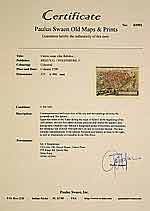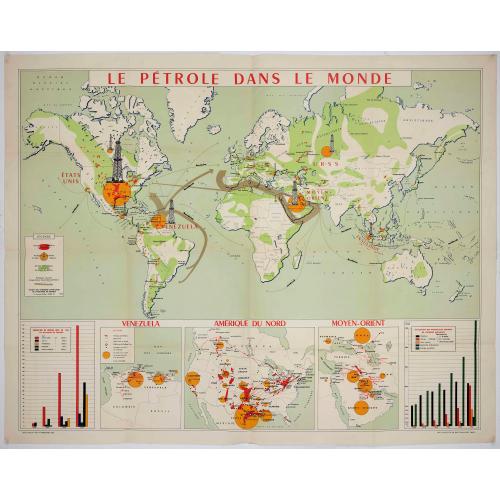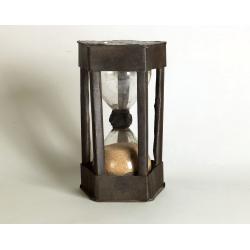Description
FIRST EDITION: Poster published by the Union of Union Chambers of the Petroleum Industry. Large world map showing the oil fields in the world: United States, U.S.S.R., Venezuela, Mexico and the Middle East. Three separate inset maps show the oil fields in Venezuela, North America and the Middle East (Iraq, Iran, Kuwait, Saudi Arabia, Bahrain and Qatar).
The main map provides an overview of the global production and transportation of crude oil. Regions shaded bright red represent fields “in exploitation”, those shaded green are likely to contain oil reserves, and orange circles and drilling-rig symbols are sized in rough proportion to the output of the major oil-producing countries.
Gray arrows indicate the main sea lanes by which crude oil was shipped; using the “flow map” technique pioneered a century earlier by Charles Joseph Minard, the arrows are sized in proportion, more or less, to the volumes of oil transported on each route.
Below the main map, three insets provide detailed depictions of three of the four central oil-producing regions: Venezuela, North America, and the Middle East (The fourth region, the Soviet Union, is not so treated, perhaps because at the time it was minimally integrated with the global economy.) As on the main map, red shading indicates active oil fields, and orange circles indicate the volume of production in different regions. Additionally, small black circles and larger black stars denote refineries, while red lines indicate the routes of pipelines.
This 1956 impression constitutes the first edition; a revised 1958 issue incorporated an additional inset charting the redistribution of petroleum flows precipitated by the Suez Crisis of October–November 1956.
A chart at lower left indicates how the volume and location of oil production changed between 1900 and 1956, while a similar chart at lower right demonstrates the growing importance of oil in the overall energy “mix” during the same period. (Naturally, “renewables” are nowhere in evidence.) Finally, a small inset map at center left depicts the impact of Abdul Nasser’s closing of the Suez Canal in late 1956 on the global flow of crude oil.
A present-day crude oil production map would look similar: The United States, the Middle East, and Russia remain the top oil producers, though Venezuela’s near-total collapse has dramatically reduced its role in the market. Conversely, Brazil, China, and Norway, among others, which have no presence on this 1958 map, have in recent decades become significant producers of crude oil, while Japan, China, and the countries of Southeast Asia have all become major consumers.
The map was published by the Union des Chambres syndicales de l’industrie du pétrole, an association of trade unions in the French petroleum sector established in 1944. Not named, but I assume integral to the Union's workings and funding was the French multinational Total (formerly CFP), founded in 1924 and today considered one of the seven “supermajor” oil companies. [source: Boston Rare Maps].
Reference: OCLC 12625662 et al, giving six institutional holdings worldwide.
The main map provides an overview of the global production and transportation of crude oil. Regions shaded bright red represent fields “in exploitation”, those shaded green are likely to contain oil reserves, and orange circles and drilling-rig symbols are sized in rough proportion to the output of the major oil-producing countries.
Gray arrows indicate the main sea lanes by which crude oil was shipped; using the “flow map” technique pioneered a century earlier by Charles Joseph Minard, the arrows are sized in proportion, more or less, to the volumes of oil transported on each route.
Below the main map, three insets provide detailed depictions of three of the four central oil-producing regions: Venezuela, North America, and the Middle East (The fourth region, the Soviet Union, is not so treated, perhaps because at the time it was minimally integrated with the global economy.) As on the main map, red shading indicates active oil fields, and orange circles indicate the volume of production in different regions. Additionally, small black circles and larger black stars denote refineries, while red lines indicate the routes of pipelines.
This 1956 impression constitutes the first edition; a revised 1958 issue incorporated an additional inset charting the redistribution of petroleum flows precipitated by the Suez Crisis of October–November 1956.
A chart at lower left indicates how the volume and location of oil production changed between 1900 and 1956, while a similar chart at lower right demonstrates the growing importance of oil in the overall energy “mix” during the same period. (Naturally, “renewables” are nowhere in evidence.) Finally, a small inset map at center left depicts the impact of Abdul Nasser’s closing of the Suez Canal in late 1956 on the global flow of crude oil.
A present-day crude oil production map would look similar: The United States, the Middle East, and Russia remain the top oil producers, though Venezuela’s near-total collapse has dramatically reduced its role in the market. Conversely, Brazil, China, and Norway, among others, which have no presence on this 1958 map, have in recent decades become significant producers of crude oil, while Japan, China, and the countries of Southeast Asia have all become major consumers.
The map was published by the Union des Chambres syndicales de l’industrie du pétrole, an association of trade unions in the French petroleum sector established in 1944. Not named, but I assume integral to the Union's workings and funding was the French multinational Total (formerly CFP), founded in 1924 and today considered one of the seven “supermajor” oil companies. [source: Boston Rare Maps].
Reference: OCLC 12625662 et al, giving six institutional holdings worldwide.
FAQ - Guarantee - Shipping
Buying in the BuyNow Gallery
This item is available for immediate purchase when a "Add to Cart" or "Inquire Now" button is shown.
Items are sold in the EU margin scheme
Payments are accepted in Euros or US Dollars.
Authenticity Guarantee
 We provide professional descriptions, condition report (based on 45 years experience in the map business)
We provide professional descriptions, condition report (based on 45 years experience in the map business)
Paulus Swaen warrants the authenticity of our items and a certificate of authenticity is provided for each acquired lot.
Condition and Coloring
We indicate the condition of each item and use our unnique HiBCoR grading system in which four key items determine a map's value: Historical Importance, Beauty, Condition/Coloring and Rarity.
Color Key
We offer many maps in their original black and white condition. We do not systematically color-up maps to make them more sellable to the general public or buyer.
Copper engraved or wood block maps are always hand colored. Maps were initially colored for aesthetic reasons and to improve readability. Nowadays, it is becoming a challenge to find maps in their original colors and are therefor more valuable.
We use the following color keys in our catalog:
Original colors; mean that the colors have been applied around the time the map was issued.
Original o/l colors; means the map has only the borders colored at the time of publication.
Colored; If the colors are applied recently or at the end of the 20th century.
Read more about coloring of maps [+]
Shipping fee
A flat shipping fee of $ 30 is added to each shipment by DHL within Europe and North America. This covers : International Priority shipping, Packing and Insurance (up to the invoice amount).
Shipments to Asia are $ 40 and rest of the world $50
We charge only one shipping fee when you have been successful on multiple items or when you want to combine gallery and auction purchases.
Read more about invoicing and shipping
FAQ
Please have a look for more information about buying in the BuyNow gallery
Many answers are likely to find in the general help section.
Virtual Collection
![]()
With Virtual Collection you can collect all your favorite items in one place. It is free, and anyone can create his or her Virtual map collection.
Unless you are logged in, the item is only saved for this session. You have to be registed and logged-in if you want to save this item permanently to your Virtual Collection.
Read More[+]
Register here, it is free and you do not need a credit card.
Add this item to
Virtual Collection
or click the following link to see my Virtual Collection.
| Digital Image Download | |
|
Paulus Swaen maintains an archive of most of our high-resolution rare maps, prints, posters and medieval manuscript scans. We make them freely available for download and study. Read more about free image download |
In accordance with the EU Consumer Rights Directive and habitually reside in the European Union you have the right to cancel the contract for the purchase of a lot, without giving any reason.
The cancellation period will expire 14 calendar days from the day after the date on which you or a third party (other than the carrier and indicated by you) acquires, physical possession of the lot. To exercise the right to cancel you must inform Paulus Swaen Inc, of your decision to cancel this contract by a clear statement (e.g. a letter sent by post, or e-mail (amsterdam@swaen.com).
To meet the cancellation deadline, it is sufficient for you to send your communication concerning your exercise of the right to cancel before the cancellation period has expired.

